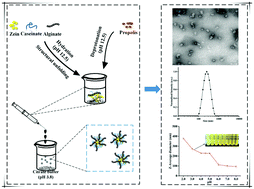当前位置:
X-MOL 学术
›
Food Funct.
›
论文详情
Our official English website, www.x-mol.net, welcomes your
feedback! (Note: you will need to create a separate account there.)
One-step assembly of zein/caseinate/alginate nanoparticles for encapsulation and improved bioaccessibility of propolis†
Food & Function ( IF 5.1 ) Pub Date : 2018-12-26 00:00:00 , DOI: 10.1039/c8fo01614c Hao Zhang 1, 2, 3, 4 , Yuying Fu 1, 2, 3, 4, 5 , Yujuan Xu 4, 6, 7, 8 , Fuge Niu 1, 2, 3, 4 , Zeya Li 1, 2, 3, 4 , Chujie Ba 1, 2, 3, 4 , Bing Jin 1, 2, 3, 4 , Guowen Chen 1, 2, 3, 4 , Xiaomeng Li 1, 2, 3, 4
Food & Function ( IF 5.1 ) Pub Date : 2018-12-26 00:00:00 , DOI: 10.1039/c8fo01614c Hao Zhang 1, 2, 3, 4 , Yuying Fu 1, 2, 3, 4, 5 , Yujuan Xu 4, 6, 7, 8 , Fuge Niu 1, 2, 3, 4 , Zeya Li 1, 2, 3, 4 , Chujie Ba 1, 2, 3, 4 , Bing Jin 1, 2, 3, 4 , Guowen Chen 1, 2, 3, 4 , Xiaomeng Li 1, 2, 3, 4
Affiliation

|
The design of zein-based nanoparticles to encapsulate bioactive molecules has gained great attention in recent years. However, the use of ethanol to dissolve zein presents flammability concerns and the scale-up production of zein-based nanoparticles is also a concern. In our study, propolis loaded zein/caseinate/alginate nanoparticles were fabricated using a facile one-step procedure: a well-blended solution was prepared containing deprotonated propolis, soluble zein, dissociated sodium caseinate micelles (NaCas) and alginate at alkaline pH, and then this alkaline solution was added to 0.1 M citrate buffer (pH 3.8) to fabricate composite nanoparticles without using organic solvents and sophisticated equipment. During acidification, the alginate molecules adsorbed on the zein/NaCas surfaces by electrostatic complexation, which improved the stability towards aggregation of zein/NaCas nanoparticles under gastrointestinal (GI) or acidic pH. The nanoparticles prepared under the optimized method (method 3 sample) were of spherical morphology with a particle size around 208 nm and a negative zeta potential around −27 mV. The encapsulation efficiency (EE) and loading capacity (LC) of propolis reached 86.5% and 59.6 μg mg−1 by zein/NaCas/alginate nanoparticles, respectively. These nanoparticles were shown to be stable towards aggregation over a wide range of pH values (2–8) and salt concentrations (0–300 mM NaCl). Compared to free propolis, the bioaccessibility of propolis encapsulated with nanoparticles was increased to 80%. Our results showed a promising clean and scalability strategy to encapsulate hydrophobic nutraceuticals for applications in foods, supplements, and pharmaceuticals.
中文翻译:

玉米醇溶蛋白/酪蛋白酸盐/藻酸盐纳米颗粒的一步式组装,用于蜂胶的封装和改善的生物利用度†
近年来,基于玉米醇溶蛋白的纳米颗粒包裹生物活性分子的设计引起了极大的关注。然而,使用乙醇溶解玉米蛋白存在易燃性问题,并且基于玉米蛋白的纳米颗粒的大规模生产也是关注的问题。在我们的研究中,使用简便的一步步骤制备了装载蜂胶的玉米蛋白/酪蛋白酸盐/藻酸盐纳米颗粒:制备了混合良好的溶液,其中包含去质子化的蜂胶,可溶性玉米蛋白,酪蛋白酸钠胶束(NaCas)和藻酸盐在碱性pH下的解离,以及然后将这种碱性溶液添加到0.1 M柠檬酸盐缓冲液(pH 3.8)中,无需使用有机溶剂和复杂的设备即可制备复合纳米颗粒。在酸化过程中,藻酸盐分子通过静电络合吸附在玉米蛋白/ NaCas表面上,这改善了在胃肠道(GI)或酸性pH下玉米醇溶蛋白/ NaCas纳米颗粒聚集的稳定性。在优化方法下制备的纳米颗粒(方法3样品)呈球形,粒径约为208 nm,负ζ电位约为-27 mV。蜂胶的包封率(EE)和负载量(LC)分别达到86.5%和59.6μgmg玉米醇溶蛋白/ NaCas /藻酸盐纳米颗粒分别为-1。这些纳米颗粒在很宽的pH值(2-8)和盐浓度(0-300 mM NaCl)范围内都表现出稳定的聚集性。与游离蜂胶相比,纳米颗粒包裹的蜂胶的生物利用度提高到80%。我们的结果显示了一种有前景的清洁和可扩展性策略,可以将疏水性营养保健品封装在食品,补品和药品中。
更新日期:2018-12-26
中文翻译:

玉米醇溶蛋白/酪蛋白酸盐/藻酸盐纳米颗粒的一步式组装,用于蜂胶的封装和改善的生物利用度†
近年来,基于玉米醇溶蛋白的纳米颗粒包裹生物活性分子的设计引起了极大的关注。然而,使用乙醇溶解玉米蛋白存在易燃性问题,并且基于玉米蛋白的纳米颗粒的大规模生产也是关注的问题。在我们的研究中,使用简便的一步步骤制备了装载蜂胶的玉米蛋白/酪蛋白酸盐/藻酸盐纳米颗粒:制备了混合良好的溶液,其中包含去质子化的蜂胶,可溶性玉米蛋白,酪蛋白酸钠胶束(NaCas)和藻酸盐在碱性pH下的解离,以及然后将这种碱性溶液添加到0.1 M柠檬酸盐缓冲液(pH 3.8)中,无需使用有机溶剂和复杂的设备即可制备复合纳米颗粒。在酸化过程中,藻酸盐分子通过静电络合吸附在玉米蛋白/ NaCas表面上,这改善了在胃肠道(GI)或酸性pH下玉米醇溶蛋白/ NaCas纳米颗粒聚集的稳定性。在优化方法下制备的纳米颗粒(方法3样品)呈球形,粒径约为208 nm,负ζ电位约为-27 mV。蜂胶的包封率(EE)和负载量(LC)分别达到86.5%和59.6μgmg玉米醇溶蛋白/ NaCas /藻酸盐纳米颗粒分别为-1。这些纳米颗粒在很宽的pH值(2-8)和盐浓度(0-300 mM NaCl)范围内都表现出稳定的聚集性。与游离蜂胶相比,纳米颗粒包裹的蜂胶的生物利用度提高到80%。我们的结果显示了一种有前景的清洁和可扩展性策略,可以将疏水性营养保健品封装在食品,补品和药品中。











































 京公网安备 11010802027423号
京公网安备 11010802027423号